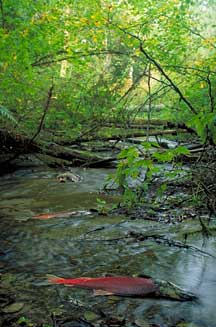The Value of Riparian Vegetation

Bank stabilization and water quality protection
The roots of riparian trees and shrubs help hold streambanks in place, preventing erosion. Riparian vegetation also traps sediment and pollutants, helping keep the water clean.
Fish habitat
As dying or uprooted trees fall into the stream, their trunks, root wads, and branches slow the flow of water. Large snags create fish habitat by forming pools and riffles in the stream. Riffles are shallow gravelly sections of the stream where water runs faster. Many of the aquatic insects that salmon eat live in riffles. Salmon also require riffles for spawning. They use pools for resting, rearing and refuge from summer drought and winter cold.
Wildlife habitat
Over 80 percent of all wildlife species in western Washington use riparian areas during some part of their life cycle. Riparian vegetation provides food, nesting, and hiding places for these animals. Unfortunately, forested riparian areas account for the smallest percentage of forest land in Washington.
Food chain support
Salmon and trout, during the freshwater stage of their life cycle, eat mainly aquatic insects. Aquatic insects spend most of their life in water. They feed on leaves and woody material such as logs, stumps and branches that fall into the water from streambanks. Standing riparian vegetation is habitat for other insects that sometimes drop into the water, providing another food source for fish.
Thermal cover
Riparian vegetation shields streams and rivers from summer and winter temperature extremes that may be very stressful, or even fatal, to fish and other aquatic life. The cover of leaves and branches brings welcome shade, ensuring that the stream temperature remains cool in the summer and moderate in the winter. Cooler, shaded streams have less algae and are able to hold more dissolved oxygen, which fish need to breathe.
Flood control
During high stream flows, riparian vegetation slows and dissipates floodwaters. This prevents erosion that damages fish spawning areas and aquatic insect habitats.
Riparian vegetation is essential for maintaining high water quality in streams, rivers, lakes, and along shorelines. However, riparian vegetation remains relatively unprotected from poor agricultural practices, residential and commercial construction, landscaping, and logging. In recognition of this, the King County Sensitive Areas Code (SAC) requires the preservation of riparian vegetation along streams, around wetlands, and in other sensitive areas in order to protect the water quality and habitat value of these areas. In addition, King County Water and Land Resources restores riparian areas that have been damaged through restoration projects and volunteer replanting projects.

 Translate
Translate